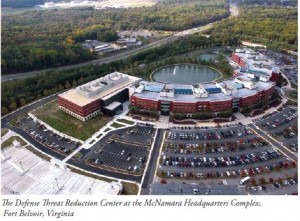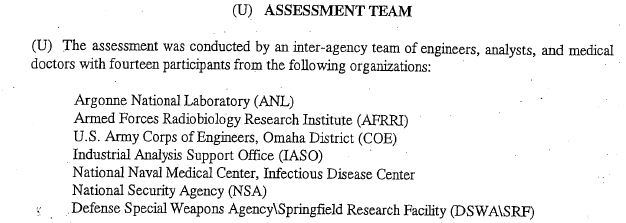
The 317,000 square foot DTRA headquarters opened in 2005 to bring together the agency's 2000 employees.
[Note: This post has been updated to correct an error regarding the location of the Project BACUS facility. Erroneous material has not been deleted but has been put into strikethrough font.]
In following up on yesterday’s announcement that the family of Robert Stevens, the first victim in the 2001 anthrax attacks, has settled their wrongful death suit with the US Government for $2.5 million, Marcy came across a number of documents recently released through the case. One of those documents got my attention from its title: “Integrated Capabilities Assessment of the U.S. Army Medical Research Institute of Infectious Diseases” (USAMRIID Capabilities pdf). I had anticipated that the document would be a technical assessment that would be relevant to the question of whether the facilities and equipment available to Bruce Ivins would have been appropriate for production of the anthrax spores used in the 2001 attacks. However, it turns out that the document was a report on a 1996 security assessment of the USAMRIID facility where Ivins worked. I almost moved on to other documents, but then I saw the list of agencies that conducted the review:
 The last entry on the list is what stands out. The Defense Special Weapons Agency was folded into the newly formed Defense Threat Reduction Agency, or DTRA, in late 1998. And DTRA was important to me because they were the agency that carried out Project BACUS, first reported by Judy Miller on September 4, 2001. Miller’s Times article described DTRA building a facility at the
The last entry on the list is what stands out. The Defense Special Weapons Agency was folded into the newly formed Defense Threat Reduction Agency, or DTRA, in late 1998. And DTRA was important to me because they were the agency that carried out Project BACUS, first reported by Judy Miller on September 4, 2001. Miller’s Times article described DTRA building a facility at the Dugway Proving Grounds in Utah Nevada Test Site with a 50 liter fermenter capable of producing bioweapons microbes. The project was an exercise to determine how difficult it would be for authorities to spot a bioweapons production facility built by terrorists. Later, I found that in her bioweapons book published in 2001, Miller disclosed that the BACUS facility also is capable of weaponizing bacterial spores.
With those bits of history in mind, some of the findings from the 1996 assessment stand out. From the introductory material, we find this summary:
It was noted that theft of biological agents from USAMRIID was a significant part of the threat to USAMRIID:
 As if that warning didn’t anticipate 2001 enough, they go further and point out that theft of a biological agent most likely would be by insiders:
As if that warning didn’t anticipate 2001 enough, they go further and point out that theft of a biological agent most likely would be by insiders:
 The report also makes a point about there being an inventory of biological agents at USAMRIID:
The report also makes a point about there being an inventory of biological agents at USAMRIID:
A second document describes an assessment by the Defense Special Weapons Agency acting alone this time in a vulnerability assessment of the Fort Detrick area as a whole. This assessment was conducted in early 1998 and USAMRIID was included among the facilities assessed. (USAMRIID Vulnerability 1998 pdf). This document is more heavily redacted than the 1996 document and appears to be more focused on the physical aspects of the facilities, but sabotage, criminal activity and terrorism were listed among the threats evaluated, so it seems likely that at least part of the 1998 work addressed the issues from 1996 listed above.
These new bits of information from the two documents reinforced my thinking about the possibility of the Project BACUS facility at Dugway the Nevada Test Site being the true source of the anthrax attack material. In the post cited above where I discussed the weaponization capability of BACUS, I also provided this explanation from McClatchy Reporter Greg Gordon on how the FBI eliminated Dugway personnel as suspects:
At Dugway, which unlike USAMRIID did make anthrax powder, the FBI examined who was present at work and during what hours on the days before the anthrax was postmarked. The bureau concluded that none of Dugway’s researchers could have flown to New Jersey and back during their windows of opportunity.
So Dugway personnel were excluded as suspects because they could not have acted alone. If we instead allow for a small group within DTRA acting in concert, we can build the following hypothetical on how DTRA could have been involved in the attacks:
The BACUS facility was built by DTRA, and now we have DTRA personnel visiting USAMRIID in 1996 and 1998 to assess its security weaknesses. In 1996, they brought up the possibility of an internal theft of biological materials that could be grown into weapon material. They also noted that there is a central list with an inventory of material that could turn into threats. By the time they returned in 1998, Bruce Ivins’ RMR-1029 flask would have been on that list, as RMR-1029 was produced in 1997 (see this post for details).
In the case of DTRA, however, it likely was not necessary to steal material directly from RMR-1029 (even though it is possible that such an opportunity presented itself during visits for the 1998 assessment), because most of the material in RMR-1029 had been produced in a different fermenter at Dugway in the first place. It seems highly likely that at the time Project BACUS was getting underway at Dugway the Nevada Test Site materials from this work for Ivins still would have been present at Dugway from which the 2001 attack material could have been cultured. For example, old Petri dishes of cultures used to inoculate the production fermenter or reference samples retained when the spores were shipped to Ivins might have been present at Dugway and available to Project BACUS personnel. [Correction: the earlier version of this article mis-stated that the BACUS facility was at Dugway, when it in fact was constructed at the Nevada Test Site. We now must account for Project BACUS personnel visiting Dugway to get inoculum, getting it directly from USAMRIID during the 1998 security assesment, or getting it in a less direct manner.]
So now we have Project BACUS personnel with the appropriate facility for producing and weaponizing the material used in the attacks and likely with access to inoculum that would result in the genetic signature seen in the actual attack material.
That takes care of means and opoortunity. How about motive? Take a look at the photo at the top of this post showing the huge facility that DTRA was able to build in 2005. Although the 9/11 attacks likely would be seen as the primary force behind this sort of investment in DTRA in this time period, the importance of the anthrax attacks for the ascendance of DTRA shouldn’t be overlooked.
Once we get into the concept of a Defense agency being involved, we then see the logic of the targeting. Tom Daschle and Pat Leahy were outspoken critics of the Patriot Act and their mailings went out just after publication of their criticism. Robert Stevens becomes an interesting early target because he was involved in publication of an unflattering photo of Jenna Bush in the National Enquirer.
The location of DTRA in suburban Washington places a large number of DTRA personnel within the same distance of the critical Princeton mailbox as Bruce Ivins. At least some DTRA personnel in the DC area have enough knowledge of anthrax that this 2008 conference (pdf) on the impact of an anthrax “event” had five DTRA attendees. It is not difficult to envision how the attack letters could have been prepared at the Project BACUS site at Dugway the Nevada Test Site and then sealed into a non-permeable pouches for transport to Princeton, where the pouches could have been slit with the letters sliding into the mailbox.
Of course, all of this “evidence” against DTRA is merely circumstantial. But to me, it is a circumstantial case that is far stronger than the FBI’s circumstantial case against Bruce Ivins.

